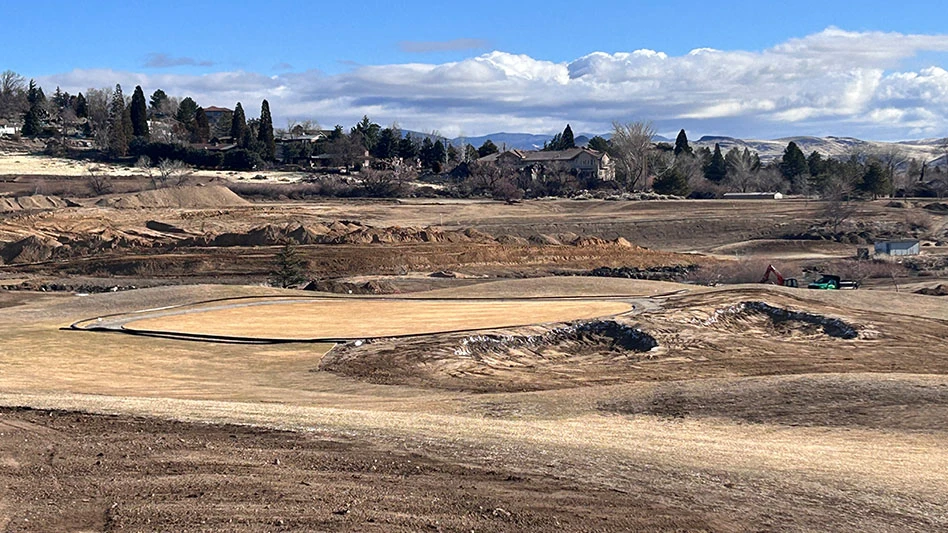While superintendents are discovering plant growth regulators serve a number of purposes on the golf course – including clipping and fuel-cost reductions – some superintendents affirm the main reason they use PGRs is to maintain a quality product. That’s to say they’re bent on suppressing Poa annua as best as they can.
As two superintendents prove, that task might lead to pushing the envelope in terms of application rates and methods.
Troy Flanagan inherited a Poa-infested course when he became the superintendent at Anthem Country Club in Henderson, Nev.
“When I got here two and a half years ago, one of the biggest concerns of the membership was the greens were becoming infested with Poa,” he says.
The situation was getting so bad, Flanagan wouldn’t have been surprised if the members began considering completely rebuilding the greens. Right away he started a Trimmit program, spraying every two weeks during the spring, summer and fall to slow the Poa and allow the bentgrass to overtake it.
“The Poa is getting better, but it’s not gone yet,” Flanagan says.
Luckily, the program has prevented any talk of a total greens rebuild, which Flanagan estimates would have cost the club about $1.45 million, not counting the revenue loss from closing for three to four months.
“The membership is happy the ball’s rolling,” he says. “I hope by the end of next summer the Poa on the greens will be mostly gone.”
At the same time, the Poa population had become unwieldy in the fairways, rough and tees, too. The 18-hole course was sprigged with 419 bermudagrass when it was built in 1998, and it’s overseeded with ryegrass every September. Flanagan estimates the Poa population was at 6 or 7 percent the year of the Trimmit program.
“That might not sound like a lot, but part of the problem with Poa is if you have it in the fairways and the rough, the seedheads will move around easier and infest the greens,” he says.
To gain control, Flanagan instituted a PGR program on the rest of the course, too, including two postoverseeding applications of Primo Maxx, two fall applications of Trimmit, a Trimmit application in March, monthly applications only to the fairways from April to July and one final high-rate (0.75 ounce per 1,000 square feet) Primo application before overseeding, which takes place around Labor Day.
“It’s been phenomenal,” he says. “The Trimmit has taken the Poa population down to less than 1 percent.”
An added bonus has been reducing fairway mowing.
“In the summer, our slower time for golf, we started mowing fairways two times a week instead of three,” Flanagan says. “That saves me labor and fuel. Is it a lot? Well, it’s not the main reason I use the growth regulators – that’s for quality of product – but it’s important with the high cost of fuel.”
Though Flanagan’s made some strides with his aggressive PGR programs, he’s experienced bumps along the way.
“We have to be careful about stunting the greens,” he says. “It’s happened before. We’ve been too aggressive, they’ve gone off color and essentially stopped growing.”
Though such a situation can make golfers happy because of faster greens, it compromises the greens’ ability to recover from any stress.
“When that happened, we knew we had to back off and make an extra fertilizer application to get them to grow out,” Flanagan says.
He also learned a lesson after making Trimmit applications to the greens, fairways and rough during the winter months. In addition to going off color, it took most of the winter for the greens to regain their ability to grow.
“The first year we continued to make applications every other week during the whole winter on greens,” Flanagan says. “They turned grey – the members asked a lot of questions. We knew we definitely shocked them.”
Flanagan learned Mother Nature is a growth regulator herself, so there’s no need to make applications during the coldest months in Nevada. Last winter, the second season of his aggressive PGR program, Flanagan only made Trimmit applications on greens during weeks when the weather was warm, not every other week.
A dab will do you
Experimenting with PGRs to control Poa also has yielded good results at Merion Golf Club in Ardmore, Pa. There, director of golf course operations Matt Shaffer oversees 50 employees working on two courses – the championship East Course and the West Course. The championship course, which is preparing to host the 2009 Walker Cup and the 2013 U.S. Open, has hosted 16 USGA championships, more than any other golf course.
“We use PGRs for two primary reasons – Poa control and playability,” Shaffer says, noting the East Course’s 13-year-old bentgrass greens are about 5 percent Poa.
Combined, the courses have an annual maintenance budget of about $2.8 million. Less than 2 percent of that is spent on PGRs.
“But they have more than a 70-percent effect on our playability,” says Shaffer, who maintains Merion’s greens daily with Stimpmeter readings of 11 to 12.
Because the maintenance staff is so vigilant about the course’s playability, it has experimented with a unique PGR application method during the past few years.
“Starting in the very early spring, we dab the Poa with a 20x rate of Cutlass and Primo and then we continue to maintain our regular spray applications overtop,” Shaffer says. “It turns the Poa jet black, completely shutting it off. The Cutlass goes crazy on the bent, and it crawls across the void. It looks horrible, but it doesn’t affect putting.”
Shaffer credits Merion’s agronomist, Dave Petfield, with creating this strictly experimental application method.
“He came up with it four or five years ago, and we’ve been doing it ever since,” Shaffer says. “Dabbing is really common, but I don’t know anyone else who does it with a 20x rate of Cutlass and Primo. We’ve been doing it for a number of years, and that product was never commercially available. Now that product is called Legacy.”
Merion’s maintenance staff began using Legacy on its West course this season at 6 to 6.5 ounces per acre. Previously, it had been applying Trimmit at 35 ounces per acre.
“It’s now a quarter of the cost and 100 percent more effective,” Shaffer says.
There are some potential drawbacks to this method, Shaffer acknowledges. One is bumpiness. Merion double-cuts and rolls greens daily, but courses with a higher height of cut might not create the smooth surface that makes this method work.
The second is color. Jet-black spots on the greens aren’t something members expect.
“You have to educate your members,” Shaffer says. Sooner or later they understand, especially when it doesn’t affect play.”
But TV viewers are another story.
“We used this method this spring, but we probably won’t next year because of the Walker Cup,” Shaffer says. “Our members understand, but the general public might not.”

Explore the January 2009 Issue
Check out more from this issue and find your next story to read.
Latest from Golf Course Industry
- The Cabot Collection announces move into course management
- Carolinas GCSA raises nearly $300,000 for research
- Advanced Turf Solutions’ Scott Lund expands role
- South Carolina’s Tidewater Golf Club completes renovation project
- SePRO to host webinar on plant growth regulators
- Turfco introduces riding applicator
- From the publisher’s pen: The golf guilt trip
- Bob Farren lands Carolinas GCSA highest honor







